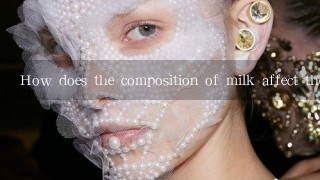How does the composition of milk affect the effectiveness of the mask?

The composition of milk can significantly impact the effectiveness of a mask. Here's how:
1. Protein content:
- Milk proteins, particularly casein, help form a protective barrier on the skin's surface, preventing the mask from being absorbed into the body.
- A high protein content mask may be more effective in retaining the mask's active ingredients.
2. Fat content:
- Some masks with a higher fat content, such as coconut oil or shea butter, can help lock in the mask's hydrating and nourishing properties.
- Fat can also help the mask glide on smoothly and leave a richer, more comfortable feel.
3. pH level:
- Milk masks with a pH above 7 are generally gentler on the skin and can help prevent irritation.
- A pH below 7 can be drying and irritating, especially for sensitive skin.
4. Emulsifying properties:
- Emulsifying milk ingredients, such as glycerin or aloe vera, can help break down the mask into smaller droplets, making it easier for the skin to absorb.
- This can improve the mask's efficacy and provide a more comfortable application experience.
5. Additives and preservatives:
- Some milk masks may contain additives or preservatives, such as preservatives to prevent spoilage or stabilizers to improve shelf life.
- These ingredients can affect the mask's texture and performance.
6. Texture:
- The texture of the milk can also impact its effectiveness.
- Thick, creamy masks may provide a richer and more nourishing experience, while thinner, lighter masks may be more suitable for sensitive skin.
7. Compatibility with skin type:
- Certain milk types may be more suitable for specific skin types. For example, oat milk is often recommended for sensitive skin, while soy milk may be better for those with dairy allergies.
Overall, the composition of milk can significantly influence the effectiveness of a mask by affecting its protein, fat, pH level, emulsifying properties, additives, preservatives, texture, and compatibility with skin type.
















































